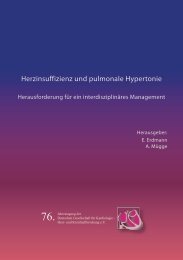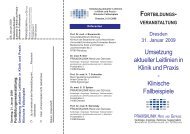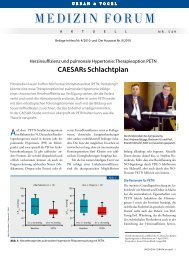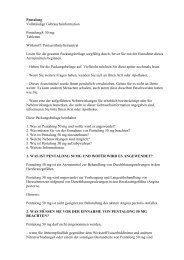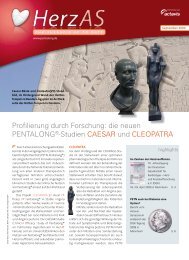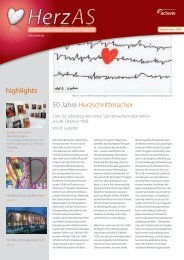HerzSupplement - Pentalong von Actavis
HerzSupplement - Pentalong von Actavis
HerzSupplement - Pentalong von Actavis
Erfolgreiche ePaper selbst erstellen
Machen Sie aus Ihren PDF Publikationen ein blätterbares Flipbook mit unserer einzigartigen Google optimierten e-Paper Software.
Summary<br />
Pentaerythritol tetranitrate (PETN) is a<br />
high potency nitrovasodilator and is used in<br />
the treatment of cardiomyopathy and angina<br />
pectoris. Bioactivation via mitochondrial<br />
aldehyde dehydrogenase (ALDH2)<br />
and other biodegradations go along with a<br />
stepwise loss of the 4 nitrate functions and<br />
result in pentaerythritol trinitrate (PEtriN),<br />
pentaerythritol dinitrate (PEdiN) and pentaerythritol<br />
mononitrate (PEmonoN). All<br />
of them contribute to the vasodilatory action.<br />
In order to confirm compliance in the<br />
field of pharmacological studies and also in<br />
order to monitor reactions of PETN with<br />
regard to enzyme kinetics, a highly sensitive<br />
analytical method, which has not been<br />
available so far has to be found. Based on<br />
previous investigations via HPLCUV [1,<br />
2], we developed a RPHPLCESIMS (reversed<br />
phase high performance liquid chromatography<br />
electrospray ionization mass<br />
spectrometry) method using a C18 column,<br />
which showed to be sensitive enough to determine<br />
the concentrations of PETN and its<br />
denitrated metabolites in biological samples.<br />
The formation of stable formiate adducts<br />
[3] further increased sensitivity and<br />
lead to LOD (limit of detection) of 10 8 M<br />
in maximum for PETN, PEtriN and PEdiN.<br />
Linearity could be shown within the whole<br />
working range for concentrations from 10 5<br />
till 10 8 M. But a comparable detection of<br />
PEmonoN could not be achieved by this<br />
protocol.<br />
Key Words: organic nitrate – quantification<br />
– formiate adduct – LCMS<br />
Danksagung<br />
Ein herzliches Dankeschön soll an dieser<br />
Stelle dem Kollegium des Lehrstuhls für<br />
Lebensmittelchemie, Institut für Ernährungswissenschaften<br />
der FriedrichSchiller<br />
Universität Jena ausgesprochen werden,<br />
welches das für die Messungen verwendete<br />
LCMSGerät zur Verfügung stellte und<br />
stets hilfsbereit bei der Beantwortung technischer<br />
Fragen war.<br />
Darüber hinaus ist zu danken Katrin Fischer<br />
sowie Monika Listing, Kolleginnen<br />
des Lehrstuhls für Pharmazeutische/Medizinische<br />
Chemie an dem Institut für Pharmazie<br />
der FriedrichSchillerUniversität<br />
Jena, für die Synthese der verwendeten<br />
Standards PEtriN, PEdiN und PEmonoN.<br />
Herz 35 · 2010 · Supplement II © Urban & Vogel<br />
Organisches Nitrat<br />
PETN<br />
PEtriN<br />
PEdiN<br />
PEmonoN<br />
Retentionszeit<br />
[min]<br />
27,70<br />
25,47<br />
16,72<br />
5,15<br />
Literatur<br />
1. Cavazzutti C, Gagliardi L, Amato A, Gattavecchia E,<br />
Tonelli D. Separation and quantitation of polynitrate<br />
esters in pharmaceutical preparations by reversedphase<br />
high-performance liquid chromatography.<br />
J Chromatogr 1982;244:391–395<br />
2. Seeling A, Lehmann J. NO-donors, part X [1]: Investigations<br />
on the stability of pentaerythrityl tetranitrate<br />
(PETN) by HPLC-chemoluminescence-N-detection<br />
(CLND) versus UV-detection in HPLC. J Pharm Biomed<br />
Anal 2006;40:1131–1136<br />
3. Zhao X, Yinon J. Identification of nitrate ester explosives<br />
by liquid chromatography-electrospray ionization<br />
and atmospheric pressure chemical ionization mass<br />
spectrometry. J Chromatogr 2002; A 977:59–68<br />
LOD<br />
[mol/l]<br />
1x10 -8<br />
7,5x10 -9<br />
1x10 -8<br />
1x10 -6<br />
Organische Nitrate<br />
LOQ<br />
[mol/l]<br />
5x10 -8<br />
2x10 -8<br />
5x10 -8<br />
5x10 -5<br />
Tab. 4: Übersicht der experimentell ermittelten Nachweis- und Bestimmungsgrenzen<br />
für PETN und seine Metaboliten. Der angegebenen LOD liegt ein Signal-<br />
Rausch-Verhältnis mit einem Mindestwert <strong>von</strong> 3 zugrunde, während die LOQ ein<br />
Signal-Rausch-Verhältnis <strong>von</strong> mindestens 10 erfordert (LOD = „limit of detection“,<br />
Nachweisgrenze; LOQ = „limit of quantification“, minimale quantifizierbare Konzentration<br />
des Analyten).<br />
Intensität<br />
8000<br />
6000<br />
4000<br />
2000<br />
0<br />
PEmonoN<br />
PEdiN<br />
0 5 10 15 20 25 30 35 40<br />
Zeit [min]<br />
PEtriN<br />
PETN<br />
Abb. 4: HPLC-MS-Chromatogramm eines Gemisches der Standardlösungen <strong>von</strong><br />
PETN, PEtriN, PEdiN und PEmonoN. Während PETN, PEtriN und PEdiN deutliche<br />
Peaks hoher Intensität zeigen, ist das PEmonoN-Signal wesentlich schwächer<br />
ausgeprägt, was ggf. auf eine geringere Stabilität des Formiat-Adduktes zurückgeführt<br />
werden kann und die Empfindlichkeit im Rahmen der Quantifizierung<br />
deutlich mindert (Konzentration der Analyten: je 10 -6 M).<br />
Für die Verfasser:<br />
Jochen Lehmann<br />
Pharmazeutisches Institut<br />
der Friedrich-Schiller-<br />
Universität Jena<br />
Lehrstuhl für Pharmazeutische/Medizinische<br />
Chemie<br />
Philosophenweg 12<br />
07747 Jena, Germany<br />
Tel.: +49 (0)3641 949825<br />
Fax: +49 (0)3641 949802<br />
E-Mail: juliane.<br />
brettschneider@uni-jena.de<br />
oder: j.lehmann@uni-jena.de<br />
11




